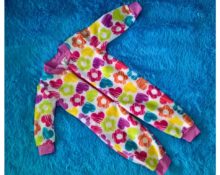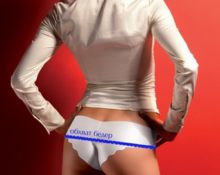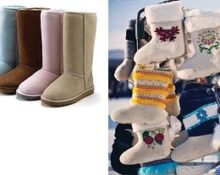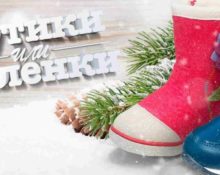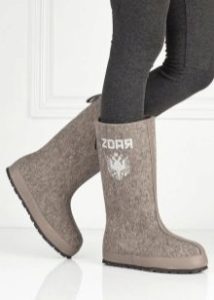 In the central part of Russia, membrane or leather winter shoes are perfectly used, but in Siberia and the Far North, where frosts rage in winter, special shoes are required. Felt boots and high boots are a good choice, thanks to which your feet will always remain warm. These are traditional shoes with a lot of history. But there is no consensus which one is warmer.
In the central part of Russia, membrane or leather winter shoes are perfectly used, but in Siberia and the Far North, where frosts rage in winter, special shoes are required. Felt boots and high boots are a good choice, thanks to which your feet will always remain warm. These are traditional shoes with a lot of history. But there is no consensus which one is warmer.
What is the main insulation of felt boots?
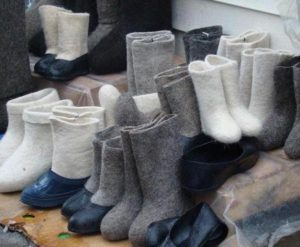 Felt boots are shoes made from natural sheep wool, created using felting. Wool has a porous structure, air easily passes between its fibers and circulates, preventing the foot from sweating. Also, the walls of the boots wick away moisture well while remaining dry. Thanks to this, felt boots are very warm.
Felt boots are shoes made from natural sheep wool, created using felting. Wool has a porous structure, air easily passes between its fibers and circulates, preventing the foot from sweating. Also, the walls of the boots wick away moisture well while remaining dry. Thanks to this, felt boots are very warm.
Wool also contains lanolin, which is known for its beneficial properties and helps relieve rheumatic, joint and muscle pain.
REFERENCE: felt boots are an excellent choice for a child, as wool removes moisture and does not allow the child’s feet to get wet or remain wet.
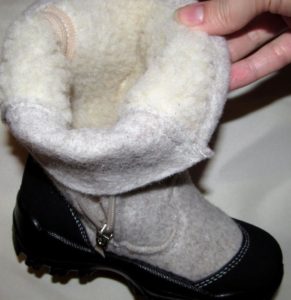 The felt boots have a free shape and do not compress the leg, which also allows you to retain heat, creating an “air” cushion. Handmade felted shoes are considered the warmest.
The felt boots have a free shape and do not compress the leg, which also allows you to retain heat, creating an “air” cushion. Handmade felted shoes are considered the warmest.
Typically, felt boots wear out faster at the bottom, on the sole, so they are equipped with a leather or rubber sole. Also, to protect against getting wet and freezing if the snow is wet, galoshes are worn along with them.
IMPORTANT! Natural felt boots retain heat well, without the addition of synthetic fibers.
How are high boots insulated?
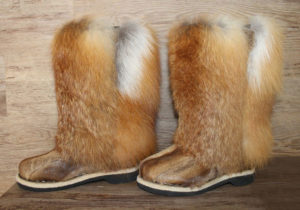 High boots originally appeared among the peoples of the Far North, where permafrost prevails. This means that the people living there know very well what kind of shoes to use. Traditional shoes are made from camus - skins from the lower part of a deer’s leg, it retains heat well and is very wear-resistant. But in the modern world, the amount of material for boots has increased; it can be the fur of an arctic fox, wolf or fox.
High boots originally appeared among the peoples of the Far North, where permafrost prevails. This means that the people living there know very well what kind of shoes to use. Traditional shoes are made from camus - skins from the lower part of a deer’s leg, it retains heat well and is very wear-resistant. But in the modern world, the amount of material for boots has increased; it can be the fur of an arctic fox, wolf or fox.
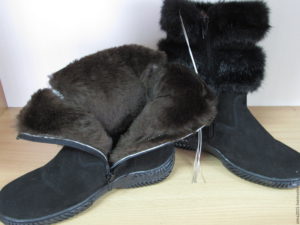 Also, such boots require fur trim not only on the outside, but also on the inside. With such shoes your feet will not freeze even in the harshest winter. Special warmth is provided by the air cavity inside each hair.
Also, such boots require fur trim not only on the outside, but also on the inside. With such shoes your feet will not freeze even in the harshest winter. Special warmth is provided by the air cavity inside each hair.
In the central part of Russia, it is possible to use fur boots with artificial fur, but this results in their thermal conductivity being lost, and they will not warm you up even at -15. Footwear of the peoples of the Far North made of natural material can withstand temperatures of minus 50 degrees or more.
What is warmer, high boots or felt boots?
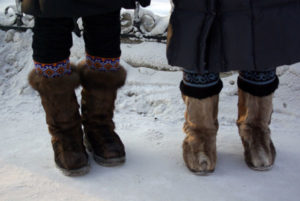 High fur boots and felt boots are two fundamentally different manufacturing methods. But they have one thing in common - they can only be worn in good frost, from minus 10. These are ideal shoes for walking outside the city and in dry frost.
High fur boots and felt boots are two fundamentally different manufacturing methods. But they have one thing in common - they can only be worn in good frost, from minus 10. These are ideal shoes for walking outside the city and in dry frost.
If you compare the layers, felt boots are made only of wool and you can additionally insulate your feet only with a wool sock.High fur boots are insulated not only on the outside, but also have insulation on the inside; it can be wool fur with a small addition of synthetics, overcoat cloth (100% wool) or sheared sheepskin - mouton. All these linings provide additional warmth to the feet. Based on this, high boots are warmer.
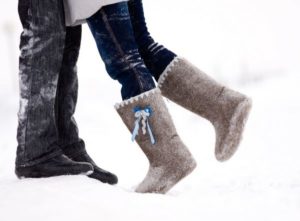 But if felt boots or high fur boots are wet, then felt boots are the best choice, since they dry quickly and can be dried next to the radiator. Due to the fur, high fur boots take a long time to dry, and due to improper drying, the skin can dry out and burst.
But if felt boots or high fur boots are wet, then felt boots are the best choice, since they dry quickly and can be dried next to the radiator. Due to the fur, high fur boots take a long time to dry, and due to improper drying, the skin can dry out and burst.
Judging by the reviews, felt boots are still more practical because:
- Some models of high boots are trimmed on the outside with fur, which collects snow and dirt.
- High boots are more difficult to care for.
- If the sole of a fur shoe is damaged, it cannot be repaired. The pair will need to be replaced. While the sole of felt boots is easy to replace.
It was decided that felt boots were better. But the choice is still yours.


 0
0